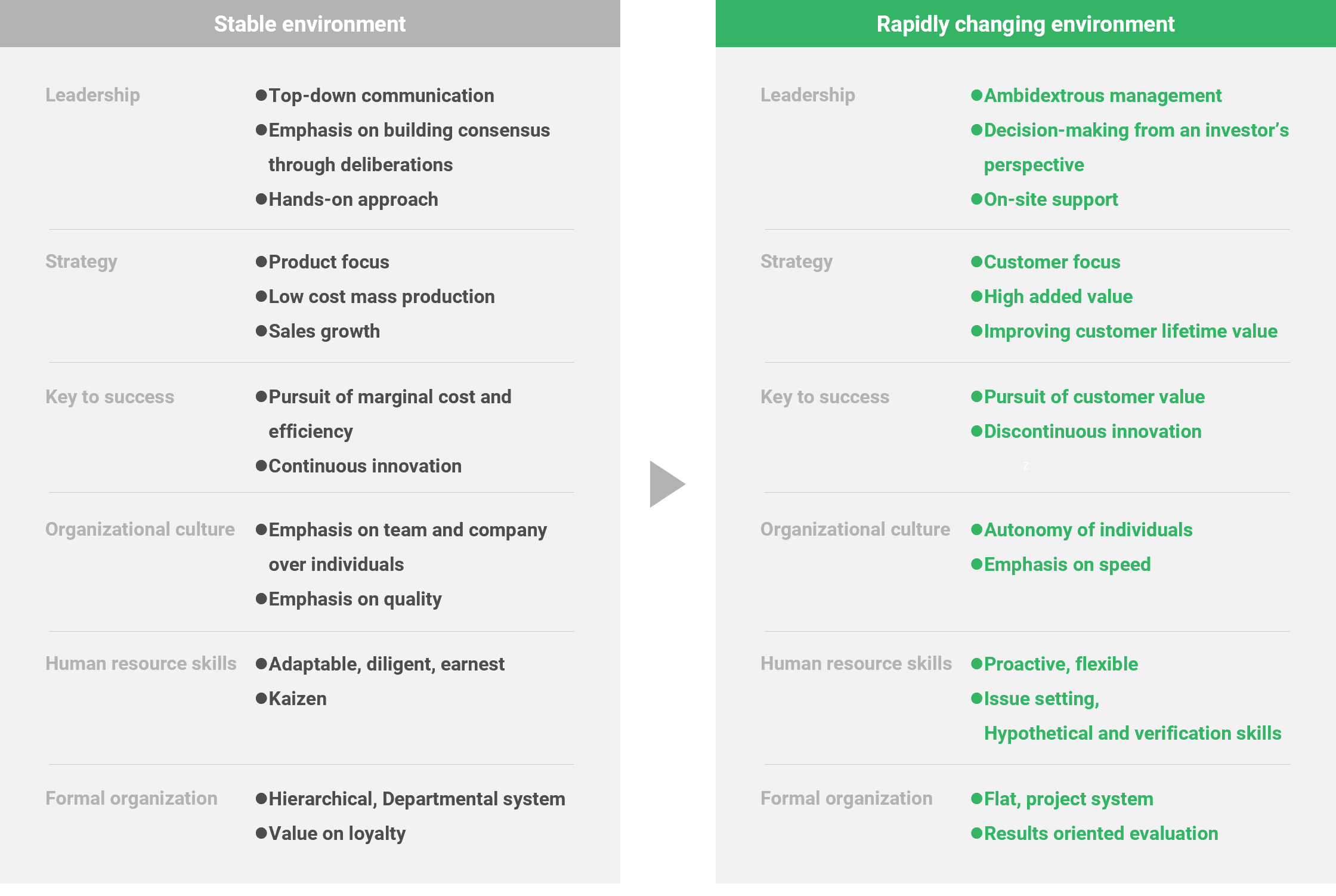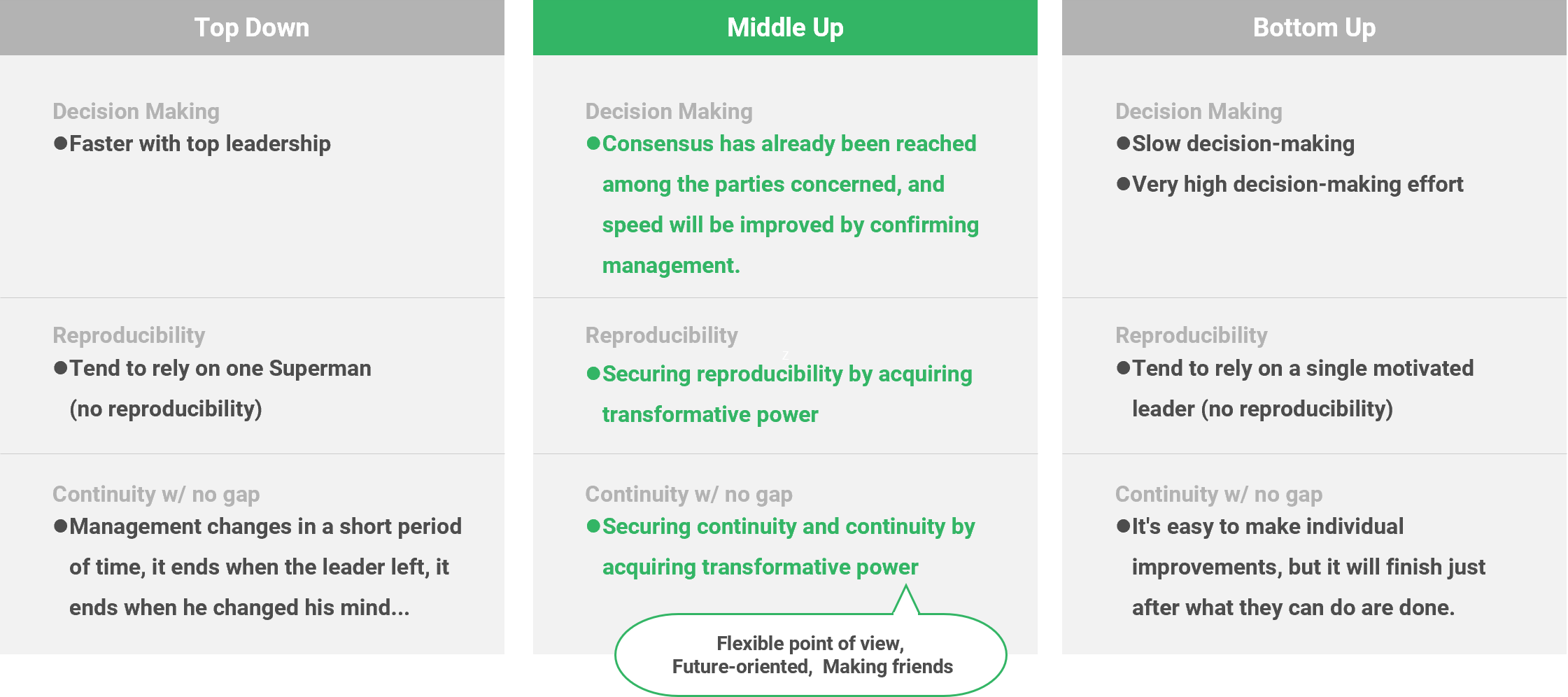SERVICE
The important themes for transformation that LTS considers
In today’s world of constant change, traditional transformation models are no longer working. In order to respond to this situation, we are proposing reform activities centered on the “middle”. “Middle” refers to general managers and section managers who are in the middle of an organization such as a company. Middle is the unique management layer working as the intermediary who can directly deliver opinions to the “top management layer” who is responsible for the core of decision-making in the current organization, and at the same time, they can actually come into contact with customers, products and service provision sites layer.
Many companies that are prospering today maintain and expand their business through unique business models and methods led by current management. It takes time to turn a business into a profitable business, but once a certain model is established, it becomes possible to reproduce it. As a result, management tends to think that “the reason for this company’s growth lies in the (past) business model and business management method”, and inevitably tends to hesitate to change the current situation that has been going well.
The top management who feels the risk of major business transformations nevertheless tries to force further transformation and improvement, and expects changes starting from the “on-site” operations. Once in the past, Japanese companies in the growth period have been supported through “on-site kaizen activities” whose goals were initiated by top management. However, up to now, people working on site have exhausted all possible improvements, and there is a situation where the employees cannot respond to orders for improvement.

Think about the burden of time that employees on-site have to hold by continuing Kaizen which has become difficult to create effects along with the regular work they have. And as the burdens, such as the occurrence of issues that transcend departments and the inability to make decisions on the issues to resolve, have come together to the employees on site in a year after another, their feeling of stagnation with nowhere to vent it speaks what difficult situations they are facing.
Under such circumstances, what is the reason for promoting organizational reform centered on the middle level management?
The current “middle” level management, unlike what top management had experienced, often does not have past success. They have been living with the economic downturn for most of the time, starting with the employment ice age, the Lehman Shock, and prolonged deflation. Since they were not in an environment where it was easy to gain successful experiences, they easily acquire the points of view and think flexibly without being bound by past successes.
The current “middle” management layer is responsible for the future of the organization even while supporting the current top management, which is finding it difficult to make appropriate decisions. They are not past-oriented, but future-oriented, and aware of their role as the core of future management.
Future-oriented mid-level department managers have a sense of crisis and unite with each other, and these make it easier for them to cooperate beyond departments and positions.
Up until now, the mainstream methods of reform in domestic companies have been two-fold: “top-down”, where changes are made at once under orders from top management, and “bottom-up”, where improvement activities are started at on-sites, and then expanded. In particular, Kaizen, which Japanese companies excelled at, is an effort to improve the efficiency and sophistication of on-site operations in production and service provision, and can be said to be a typical example of a bottom-up approach. On the other hand, top-down approach is a method in which the top a.k.a. mainly top management has cooperation, leadership and authority, and achieves transformation in a certain period of time. However, each method has its own disadvantages. In the case of a top-down approach, a strong top leader tends to make on-site passive, making it difficult to keep activities in long-term even if short-term results are achieved. Activities in bottom-up approach have already pursued improvements within one site and require improvement activities through cooperation between different sites, but the sites cannot coordinate their interests and make decisions, and keeping to maintain their desires to change becomes difficult.
“Middle-up” reform activities promoted by cooperation between middle-level personnel in each department of an organization can solve the issues in top-down and bottom-up approach. By taking the initiative from middle management, they can do what they want to do on their own instead of leaving the change to top management, and through activities they can increase the number of colleagues and create big changes.
Improve effectiveness with middle-up

The middle-up transformation activities can increase its effectiveness in terms of decision-making, reproducibility, and continuity without any gaps. For the top management, the middle managements in each department move their upper management layers, and for on-sites, they make the site organizations connect with each other, and this provides an opportunity to learn about each other’s work and roles.
“Lack of understanding of management, no change in management, no change in organization”, “Low literacy in the field, failure to cultivate awareness in the field and inability to reform.” In response to such issues, which are being asked in various organizations, if you have a sense of urgency, why don’t you gather your members who will be responsible for the future management of your organization and promote reforms?